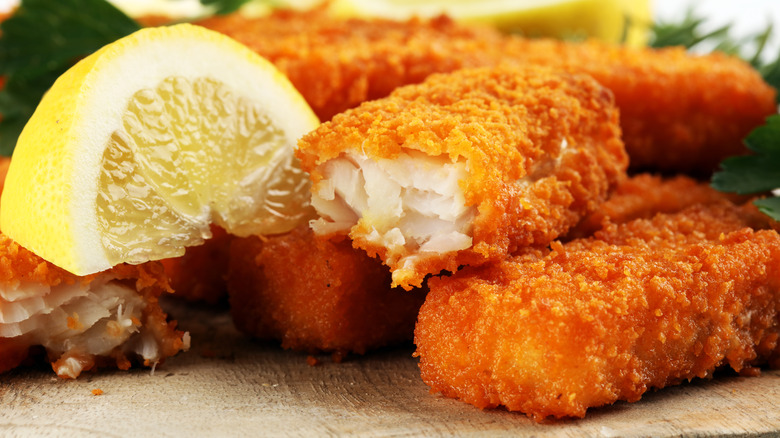Do Fish Sticks Consist Of Real Fish?
The ocean is an incredibly mysterious place. It's often said that we know more about the surface of the moon than we do about the bottom of the ocean. Water covers the majority of our planet, and is filled with a staggering variety of weird and wonderful creatures. Given the incredible scope of aquatic life, it's no wonder that things get complicated when it comes to eating underwater animals.
NPR, citing a 2013 study by the conservation organization Oceana, tells us that DNA tests of seafood samples secured at various U.S. retail stores suggest that nearly 1/3 of fish is sold as the wrong species entirely. More recently, tests carried out at several Northern California Subway locations revealed that the chain's "tuna" may not be made out of tuna fish at all, or for that matter, any other fish, per The Washington Post.
Given the sketchy history of seafood sales in this country, you might be wary about the legitimacy of everyone's favorite fried filet, the fish stick. Fortunately, you can rest assured that your fish stick almost certainly contains real fish, and that said fish likely comes from sustainable sources.
What is in a fish stick?
According to Hakai Magazine, the fish stick first flopped its way into the American diet in the 1950s. Though the frozen seafood snack has been made from a number of different white fish over the years, nowadays, they're largely prepared using Alaska pollock. Citing maritime historian Ingo Heikbrink, Hakai Magazine explains that the fish stick's benign flavor and breaded exterior help alleviate some folk's seafood aversions and that in Germany, this inoffensive style of fish preparation made people ignore the fact that the fish used was changed several times — first, it was cod, then pollock, and finally, Alaska pollock.
Pollock is the perfect choice for the fried fish stick. Flavor-wise, the meat is mild, and more importantly, it is an incredibly sustainable fish, per Climate.gov. Pollock's common use in foods like fish sticks forced the U.S. government to institute strict catch quotas in the 1970s. Alaska pollock grow fast and can reach reproduction age at around three years, which is good for their population numbers. The National Oceanic and Atmospheric Administration tell us that in 2021, over 3 billion pounds of pollock were caught.
Alaska pollock is a fried fish favorite
Gorton's Seafood crafts their fish sticks out of whole Alaska pollock filets, which are covered in a crust of crispy panko breading. Trident Seafoods uses the same fish in their sticks. Kroger's crunchy fish sticks are also made of Alaska pollock, though the meat is minced, not whole. The proprietary brand of Whole Foods Market, 365, doesn't expressly state that they use only Alaska pollock in their fish sticks, and their sticks feature a lighter breading. Similarly, Mrs. Paul's fish sticks featured a minced mixture of pollock.
Outside of the realm of frozen grocery store fish sticks, Alaska pollock appears on a number of fast-food menus. According to McDonald's, the Filet-O-Fish is made from a fried square of Alaska pollock, and the company claims to source its pollock from sustainable fisheries. The Burger King Big Fish sandwich is made with a panko-breaded hunk of 100% Alaska pollock. Finally, the seafood chain Long John Silver's has a Wild Alaska Pollock Sandwich featured prominently on their menu.


